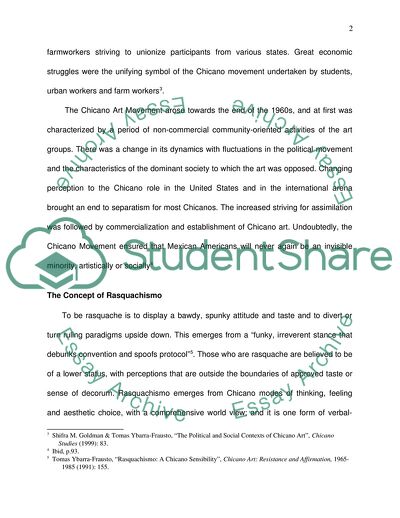
- Home
- Free Samples
- Premium Essays
- Editing Services
- Extra Tools
- Essay Writing Help
- About Us
- Studentshare
- Subjects
- Visual Arts & Film Studies
- Political and Social Background to Chicano Art
Political and Social Background to Chicano Art - Essay Example

- Subject: Visual Arts & Film Studies
- Type: Essay
- Level: Undergraduate
- Pages: 8 (2000 words)
- Downloads: 0
- Author: johnpaul93
Extract of sample "Political and Social Background to Chicano Art"
Altares embody familiar or individual histories, and the value of the artefacts is measured both sentimentally and as an offering. Since they are made by people with low incomes, symbolic richness is conveyed through the use of “glitter and shine, mirrors and glass, a profusion of golden and silvery objects, and sheer abundance”8, accounting for their artificial look. Kitsch is known as the domain of bad taste, it represents artistic endeavor gone sour, as well as anything that is considered too obvious, dramatic, repetitive, artificial or exaggerated.
The link between religious imagery and kitsch is based on the dramatic nature of their styles. An example of kitsch in religious iconography is mystic fervour represented by upturned eyes, a gaping mouth and levitation9. Amalia Mesa-Bains: The Relationship Between Rasquache and Kitsch Amalia Mesa-Bains has become well-known for her home altar recycling work, emphasizing her family tradition and cultural identity10. Throughout the years of community building among Chicana artists Amalia Mesa-Bains observed and also created artwork that was rooted in the resilient struggles of everyday life or vernacular, which are essential parts of shared working class backgrounds.
In Mesa-Bains’ opinion, rasquachismo is often misunderstood as a form of Kitsch, and has become a debated term in relation to the working classes. Chicano/ a art is oversimplified, reflecting popular culture as a form of kitsch, and grouping together the work of Cuban and Chicano/ a artists. In a discussion on kitsch and rasquachismo, it is important to identify the aspects of the vernacular key to the work of Chicana artists whose domestic locales of home, family and labor influenced their creative productions.
From the early part of the Chicano Art Movement, serious differences were made between the men and women of the movement. The concepts and techniques in the art forms specific to women give evidence to the feminist aspects of rasquachismo seen in the work on Chicana artists. These strategies highlight the patriarchal control in the domestic sphere, and attempt to bring about its decline through visual practices11. The concept of kitsch is associated with “vernacular, vulgar, inferior, tasteless, and insensible”12.
An examination of kitsch makes distinctions between mass-produced objects and intimate expressions of sincere decoration in the domestic space. Kitsch frequently defined as bad taste or false art, is also associated with the economic conditions in which the cheap, mass produced object replaces genuine folk art and is a sign of modernization in many third world countries. An association with the original folk form or lived experience of the artist may not be the basis for the artwork. Using kitsch materials may be from curiosity or recognition of that which is lost.
There is a need for greater classificatory information and a more specific definition of these phenomena. Several of the concerns pertaining to meaning and usage can be used on the Chicano phenomenon of rasquachismo or the view of the downtrodden. Rasquachismo is an underdog perspective, a world view of the have-nots, a quality exemplified in objects and places and social interactions, and it has evolved as a bicultural sensibility13. The artist using the rasquachismo perspective projects a defiant as well as inventive stand, and the irreverent and the spontaneous are used to make the most from the least.
Discards, fragments, even recycled everyday materials such as tyres, broken plates and plastic containers are recombined, with elaborate and bold display in yard shrines (capillas), domestic shrines (altares),and even decoration of the car. Broadly speaking, rasquachismo is a combination of resistant and resilient attitudes devised to allow the Chicano to survive and persevere with a sense of dignity. The core element of this concept is the capacity to hold life together with “bits of string, old coffee cans, and broken mirrors in a dazzling gesture of aesthetic bravado”14.
Read MoreCHECK THESE SAMPLES OF Political and Social Background to Chicano Art
So Far From God Critique
Chicano Studies: Latino Narrative Films
Emergence of Chicano Filmmaking
Eastside Sound and Conjunto Music in Chicano Culture
A Study in Chicano Studies
So Far from God
Mexican Music in California
The Racial and Ethnic Mexican American World

- TERMS & CONDITIONS
- PRIVACY POLICY
- COOKIES POLICY